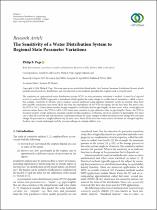 ResearchSpace
ResearchSpace
The sensitivity of a water distribution system to regional state parameter variations
JavaScript is disabled for your browser. Some features of this site may not work without it.
- ResearchSpace
- →
- Research Publications/Outputs
- →
- Journal Articles
- →
- View Item
| dc.contributor.author |
Page, Philip R

|
|
| dc.date.accessioned | 2018-06-15T06:24:39Z | |
| dc.date.available | 2018-06-15T06:24:39Z | |
| dc.date.issued | 2018-05 | |
| dc.identifier.citation | Page, P.R. 2018. The sensitivity of a water distribution system to regional state parameter variations. Mathematical Problems in Engineering, vol. 2018: Article ID 6938483. | en_US |
| dc.identifier.issn | 1024-123X | |
| dc.identifier.issn | 1563-5147 | |
| dc.identifier.uri | https://doi.org/10.1155/2018/6938483 | |
| dc.identifier.uri | https://www.hindawi.com/journals/mpe/2018/6938483/ | |
| dc.identifier.uri | http://hdl.handle.net/10204/10259 | |
| dc.description | Copyright © 2018 Philip R. Page. This is an open access article distributed under the Creative Commons Attribution License, which permits unrestricted use, distribution, and reproduction in any medium, provided the original work is properly cited. | en_US |
| dc.description.abstract | The sensitivity of a pressurised water distribution system (WDS) to state parameter variations is studied. A novel local regional sensitivity analysis (LRSA) approach is introduced which applies the same change to a collection of parameters, called a region. For example, sensitivity to suburbs can be studied. General analytical (using algebraic methods) results are derived. They show how sensible conclusions arise from LRSA and state this dependence of the WDS on regions for the first time. For most cases, theWDS is 1.852–2 times more sensitive to pipe roughness coefficients than to pipe lengths. In most cases, when certain pipes do not have minor losses, the WDS is 4.871–5.333 times more sensitive to pipe diameters than to pipe lengths. Hence, the WDS is the most sensitive to pipe diameters, medium sensitive to pipe roughness coefficients, and least sensitive to pipe lengths. For most cases, when all reservoir and tank elevations (and heads) remain the same, changes of other elevations do not change flow rates and change the pressures in a simple additive way. In most cases, when all the reservoir water surface elevations are changed together, the flow rates remain unchanged, and the pressures change in a simple additive way. | en_US |
| dc.language.iso | en | en_US |
| dc.publisher | Hindawi | en_US |
| dc.relation.ispartofseries | Worklist;20968 | |
| dc.subject | Water distribution system | en_US |
| dc.subject | Pipe network | en_US |
| dc.subject | Modelling | en_US |
| dc.subject | Uncertainty | en_US |
| dc.subject | Sensitivity | en_US |
| dc.title | The sensitivity of a water distribution system to regional state parameter variations | en_US |
| dc.type | Article | en_US |
| dc.identifier.apacitation | Page, P. R. (2018). The sensitivity of a water distribution system to regional state parameter variations. http://hdl.handle.net/10204/10259 | en_ZA |
| dc.identifier.chicagocitation | Page, Philip R "The sensitivity of a water distribution system to regional state parameter variations." (2018) http://hdl.handle.net/10204/10259 | en_ZA |
| dc.identifier.vancouvercitation | Page PR. The sensitivity of a water distribution system to regional state parameter variations. 2018; http://hdl.handle.net/10204/10259. | en_ZA |
| dc.identifier.ris | TY - Article AU - Page, Philip R AB - The sensitivity of a pressurised water distribution system (WDS) to state parameter variations is studied. A novel local regional sensitivity analysis (LRSA) approach is introduced which applies the same change to a collection of parameters, called a region. For example, sensitivity to suburbs can be studied. General analytical (using algebraic methods) results are derived. They show how sensible conclusions arise from LRSA and state this dependence of the WDS on regions for the first time. For most cases, theWDS is 1.852–2 times more sensitive to pipe roughness coefficients than to pipe lengths. In most cases, when certain pipes do not have minor losses, the WDS is 4.871–5.333 times more sensitive to pipe diameters than to pipe lengths. Hence, the WDS is the most sensitive to pipe diameters, medium sensitive to pipe roughness coefficients, and least sensitive to pipe lengths. For most cases, when all reservoir and tank elevations (and heads) remain the same, changes of other elevations do not change flow rates and change the pressures in a simple additive way. In most cases, when all the reservoir water surface elevations are changed together, the flow rates remain unchanged, and the pressures change in a simple additive way. DA - 2018-05 DB - ResearchSpace DP - CSIR KW - Water distribution system KW - Pipe network KW - Modelling KW - Uncertainty KW - Sensitivity LK - https://researchspace.csir.co.za PY - 2018 SM - 1024-123X SM - 1563-5147 T1 - The sensitivity of a water distribution system to regional state parameter variations TI - The sensitivity of a water distribution system to regional state parameter variations UR - http://hdl.handle.net/10204/10259 ER - | en_ZA |





